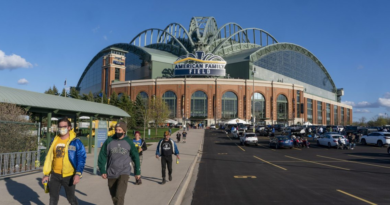Former NFL player Carl Nassib: ‘Gen Z college players are living the dream–but they could become cautionary tales if they don’t educate themselves about personal finance’
Young athletes dream big. They want to throw a game-winning touchdown in a packed stadium or hit a buzzer-beater in sold-out arenas. Those who are fortunate enough to live out these dreams in professional leagues have a chance for a big payday. Signing a multi-million-dollar contract nevertheless opens the door for major financial missteps.
Some professional athletes end up making more money than most people will see in their lifetime. Yet for every Michael Jordan and John Elway who parlayed their success into the business world, there are many more tragic stories of gifted athletes blowing it all, no matter the sport.
Now, with the NCAA’s name, image, and likeness (NIL) deals translating to big-money contracts at a much younger age, college athletes could also become cautionary tales if not given the proper skills to handle their payouts.
For the 520,000+ student athletes who competed in NCAA championship sports last year, their world is dramatically different from my time at Penn State. I started out my college career as a walk-on and worked minimum-wage jobs to earn extra cash. While most students were on summer vacation, I was in State College training in the morning, taking classes in the afternoon, and scooping ice cream at night at the famous Penn State Creamery.
It would have been a dream to earn an income from my role as an All-American at one of history’s most prestigious football programs or an endorsement from a local institution. But that dream can’t come without education. I wouldn’t have known how to manage the sudden windfall at such a young age.
It’s up to universities, collectives, and collegiate sports teams to step up and provide the right education around NIL windfalls–which have the potential to set young athletes on the path to lifelong financial freedom and even begin establishing generational wealth. Otherwise, a knowledge void threatens to leave them worse off than where they started.
Success is when preparation meets opportunity. Athletes need to prepare by getting educated so they can succeed even beyond their payday.
Although NIL income has the potential to exceed salaries in pro sports, the NIL era, now two years in, remains overshadowed by confusion and mistrust.
The majority of students were not prepared for NIL’s onset. Without the right planning, college athletes run the risk of taking on profitable endorsement deals and getting hit with similarly high tax bills without the means to pay them, or trouble navigating contingent deals with money at risk should the student not reach certain benchmarks.
In these scenarios, NIL can be the worst financial thing that ever happened to them.
Yes, history shows that young athletes are at risk of blowing through their cash. But more than that, for 18-, 19-, and 20-year-olds, figuring out how to maximize long-term benefits from NIL contracts can be a daunting if not paralyzing task.
Financial stress was a constant during my years on the Penn State football team. I haven’t taken a paycheck for granted since, and I made it my mission during my time in the NFL to help my teammates and peers build a solid financial foundation. Thankfully, financial awareness has started to gain a foothold in the locker room since the NFLPA and other players’ associations began offering financial coaching.
Gen Z, which includes the latest crop of incoming college players, tends to score the lowest in financial literacy. More education is needed across the board, and it’s heartening to see the nationwide push to educate young adults about basic money management, with several states passing legislation in the past year that mandates financial literacy as a high school graduation requirement.
It’s even more timely when we consider the scarcity of athletic scholarships, compelling many college athletes to take on crushing student loans and adding to the national student debt crisis. The lucky ones who secured funding must be coached on how to use this advantage as a springboard to transition successfully into the working world.
Athletes are used to being under the guidance of their coaches, who help to hone their skills and improve their play. It’s a natural extension for collegiate sports and university administrators–as well as the collectives that many young athletes rely upon for NIL support–to step up as financial cheerleaders off the field.
Any young athlete with a chance at a NIL deal would benefit from budgeting, saving, and investing tools before being bestowed a fortune. In the Wild West of NIL, no one wants to become the next cautionary tale–and with the right financial skills and knowledge, they can focus on dreaming big.
Carl Nassib is a former outside linebacker who played in the NFL for seven seasons, founder and CEO of social media platform Rayze, and contributor to NIL Long Game by Financial Finesse, a comprehensive online financial literacy certification program available at no cost to colleges, universities, and student athletes.
More must-read commentary published by Fortune:
- Economic pessimists’ bet on a 2023 recession failed. Why are they doubling down in 2024?
- COVID-19 v. Flu: A ‘much more serious threat,’ new study into long-term risks concludes
- Access to modern stoves could be a game-changer for Africa’s economic development–and help cut the equivalent of the carbon dioxide emitted by the world’s planes and ships
- The U.S.-led digital trade world order is under attack–by the U.S.
The opinions expressed in Fortune.com commentary pieces are solely the views of their authors and do not necessarily reflect the opinions and beliefs of Fortune.




